by Sam Tackeff | May 7, 2012 | Filipino, Restaurants
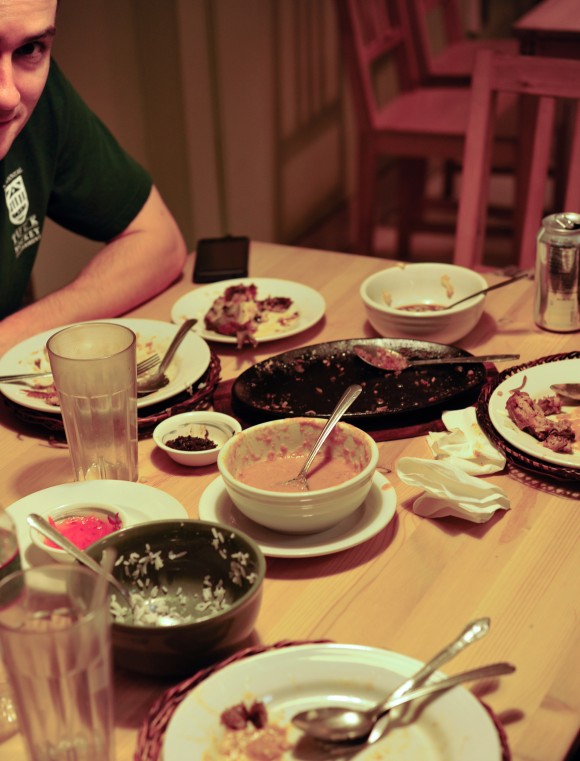
Let’s pretend here that the photos in this post have proper white balance and focus, and ignore the cold, harsh reality that even if you get a fancy new camera with a phenomenal lens, it does not mean that you will be able to properly shoot with it if you don’t know what you are doing. Also, if you hand the camera over to anyone at all, you should watch carefully that they don’t adjust the settings resulting in all your colors being off. I’m learning! – Sam
To say I’m an adventurous eater is an understatement – I’ll likely consume whatever you put down in front of me, and happily so if it has strong flavors, is fermented, or is a recognizable part of an animal.
What I’m less comfortable with is going into a restaurant for the first time where I’m the only person not speaking the native language, and ordering with confidence. Even if I’ve done my research, which I always do, and usually fairly thoroughly, I’m skeptical that I’ll be served a traditional dish in it’s full glory. I worry that the spice will be dialed back, or I’ll get fewer banchan, or the fish paste will be curiously absent from my table.
There’s a reason why Anthony Bourdain meets up with a fixer in each episode – it always helps to have someone who knows what they are talking about, and can cry foul if something is amiss.
So here I found myself craving Filipino food, and needing some dining partners and a fixer. Enter Bianca, of the delightful blog Confessions of a Chocoholic who agreed to come with me and Alex (my boss at Tasted Menu, and the creeper up there in the photo) to JnJ Turo-Turo, the ONLY Filipino restaurant within a several hundred mile radius.
From everything I had heard, it was so-so. But, after regular breakfasts in San Francisco of Silog in my old neighborhood, Hopia from Hilda’s, Señor Sisig, Hapa SF and the Adobo Hobo trucks, and Mitchell’s Ice Cream two blocks away serving up classic flavors from the Philipines including Buko (baby coconut), Langka (Jackfruit), Macapuno (coconut), and my favorite Ube (sweet purple yam) – I have learned that even not-very-good Filipino food is better than no Filipino food at all!
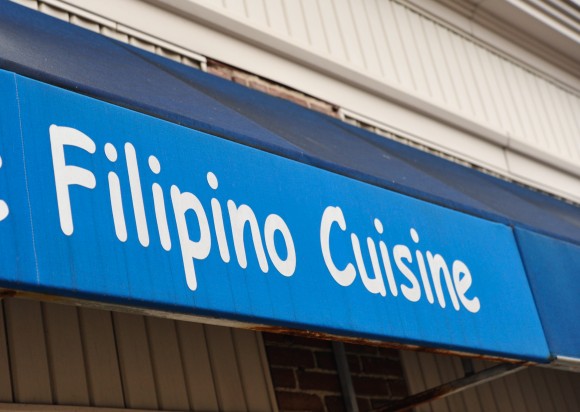
First we had to get there. This place is in Quincy, which is a bit of a hike from Boston. A thirty minute drive outside of the city got us there without too much hassle.
We made a quick detour to Kam Man Superstore right around the corner before heading in to dinner – a Chinese market about double the size of the Super 88 in Allston, and one of my favorite local places for Bento supplies. After picking up a coconut bun and a custard filled mocha bun – you can’t leave this place empty handed, no matter how hard you try – we headed over to the restaurant.
JNJ Turo-Turo isn’t exactly upscale. Turo-Turo means “point-point” in Tagalog, and generally refers to a small eatery where they have a few rotating dishes on the menu and you simply point to the ones you want. It reminded me of the places in Istanbul, neighborhood joints where working people eat or might pick up some dinner to take home after a long day. I found the place charming though, with it’s Ikea furniture, a group of friends speaking Tagalog at the next table, a quiet smiling woman cooking and serving our food, and Filipino tele-novelas dramatically unfolding in the background on the TV hanging above our table.
Bianca did the ordering, and I put in my requests – lumpiang shanghai, kare-kare and adobo and whatever else we needed.
To start, we got plates of cigarette shaped lumpiang shanghai (fried pork spring rolls) with a sweet chili dipping sauce, and slightly shorter and plumper lumpiang gulay (vegetable spring rolls filled with bean sprouts, carrots, potato and tofu) with a slightly tangy vinegar dipping sauce called sawsawan.
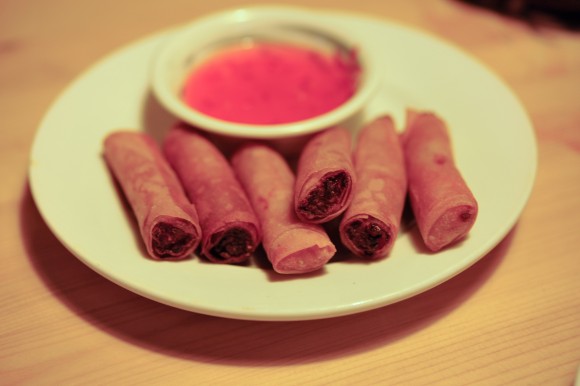
Taste-wise, these reminded me curiously of the latkes (Jewish potato pancakes) and mücver (Turkish vegetable fritters) my mom makes – I take particular delight when my brain allows me these cross-cultural associations when trying new foods.
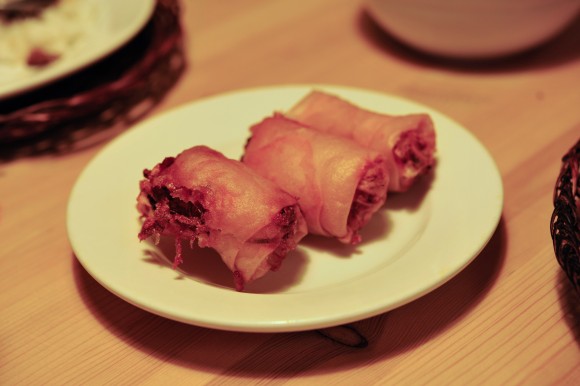
The next dish that came out was our chicken adobo, which for me was the low point of the meal. While the chicken was moist and tender, the sauce was sweet and not particularly tangy at all.
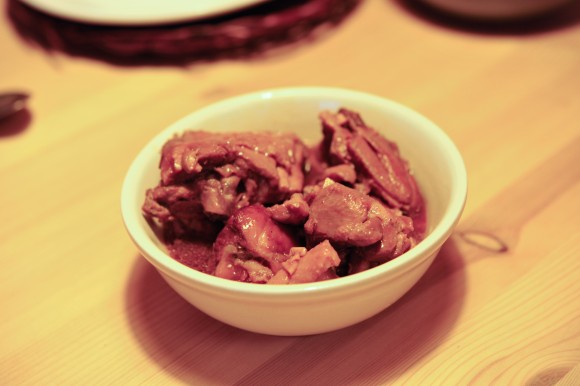
From my limited experience with adobo, I was disappointed, and felt for sure that my imaginary grandmother in Manila would have made a better version. I really like the one Amy Besa makes, which I have the recipe for on this here website and have cooked many times. After thinking about it in retrospect though, I remembered when I posted a few years back about adobo, a reader mentioned that the adobos of the North were sweetened with sugar cane and are much less acidic – so it’s possible this was a good example of that? I digress.
To my delight, the next dish to come out of the kitchen was a whole fried milk fish, (called Bangus) served split, and boneless.
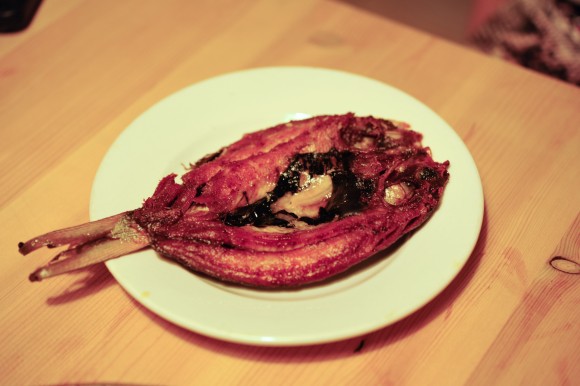
This fish, commonly eaten in the Philippines, but new to me, was crispy and brilliantly flavorful. I’m always happy when I get served a whole fish in a restaurant, and ashamed that I cook it so rarely myself at home, as it’s one of the more satisfying eating experiences one can have.
A bowl of kare-kare, a stew made with peanut sauce came out next, and was served with bagoong (shrimp paste) – which the cook looked at us skeptically and asked if we’d want. Of course I wouldn’t have turned down the opportunity to try it, and while I didn’t dislike it, I will advise you that it is not for the faint of palate.
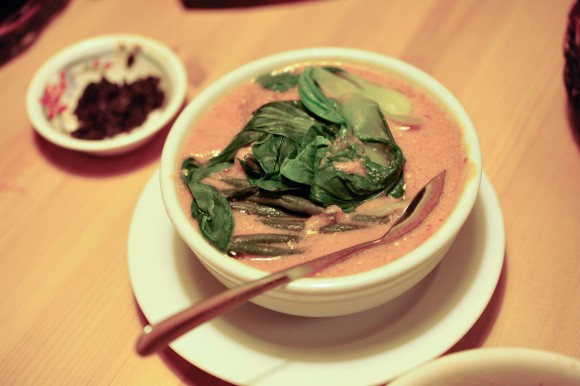
The tripe in this was cooked well, and tender, but I had been hoping for oxtail which was sadly missing from this rendition.
Even though from all that I’d read about kare-kare it’s usually described as fairly bland, I think I was hoping for a punchier dish, and the foreigner in me wanted to douse it with something acidic or spicy. Sometimes though, learning to appreciate subtlety is more important than assaulting the tastebuds – although I’m guessing that this dish would be much more flavorful with better quality nuts, cuts of meat, and the ministrations of that imaginary grandmother from Manila. I’ll be sure to try it again.
Finally, my favorite dish of the evening, the Sisig:
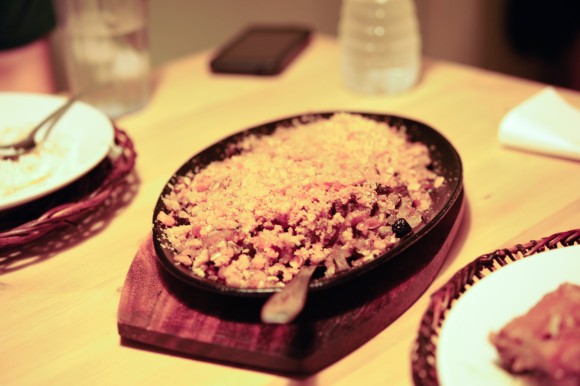
This was my first sisig experience (Señor Sisig, my favorite food truck in SF, while delicious – the California burrito, silog style with the egg is a perfect food – doesn’t actually serve it’s eponymous dish on their truck.)
Sisig is a dish comprised of the bits and pieces of the pig, ie: the good parts, and is served on a sizzling hot platter. This one was full of crunchy cartilage, and liver (my favorite) seasoned with onions, garlic, and hot pepper. I contentedly scooped my second and third helpings to eat with rice, and pitied all the folks out there who can’t deal with texture in their food.
While eating, I couldn’t help be reminded of the Turkish dish called Kokoreç, a chopped plate of intestines and other bits of offal – which I stupidly refused as a child because intestines were pretty much the grossest things that I could think of, and the last three letters of the word are pronounced “retch”. You can imagine the fuss we kids put up.
After eating our fill (ie: everything on the table), we managed to leave room for dessert: the Halo-Halo.
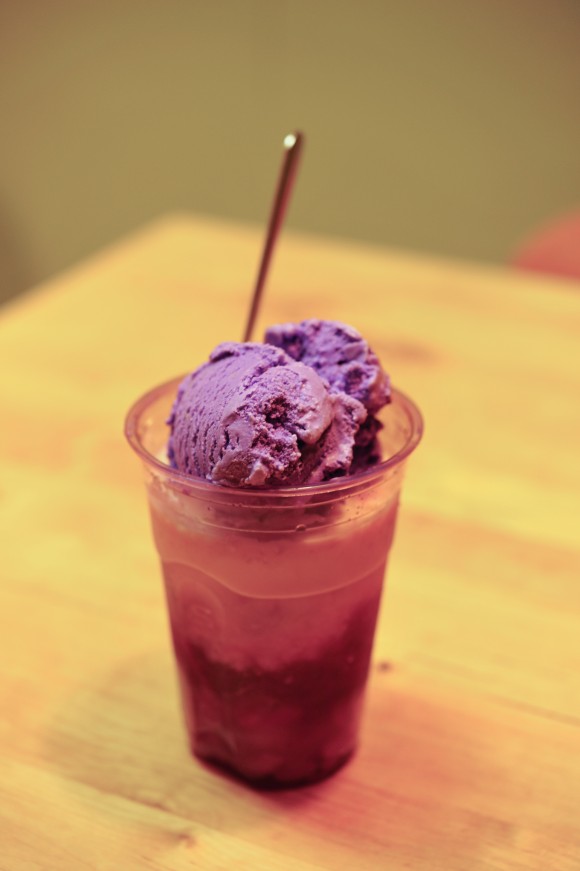
This took me straight back to summer nights when we’d walk down the street in Noe to Mitchell’s, braving the lines for a late night cone. After moving away, I’d been feeling sorry for myself that I didn’t have access to their ice cream flavors… and then BAM – finding some dee-licious Ube ice cream topping my Halo-Halo at JnJ Turo-Turo pretty much made up for the entire year of Ube-withdrawal.
So, we had … beans, banana (which I could have sworn was plantain), assorted tapioca and jelly at the bottom of the plastic Solo cup, topped with shave-ice and two scoops of Ube ice cream the exact shade of purple I would have been obsessed with in 1992. This sounds and looks a little terrifying, but I was thrilled, and ate the whole thing despite being well past the point of uncomfortable fullness.
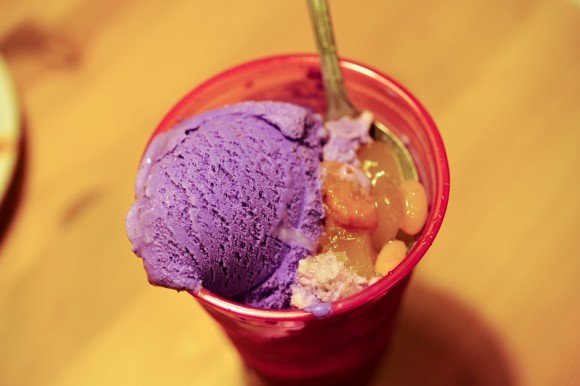
At the end of the evening, we were politely ushered out, having extended our welcome a whole half hour after they had closed, and we stumbled out smiling.
I found that while I’d gone in skeptical, this place had exceeded my expectations: it was a lovely evening, the food filled some deep needs of mine, and I was with excellent company. What more can you ask for?
JnJ Turo-Turo
143 Water St.
Quincy, MA 02169
(617) 471-8876
For more fun, here’s Bianca’s write-up of the very same dinner.

by Sam Tackeff | Sep 26, 2010 | Asian, Books, Challenge, chicken, Filipino
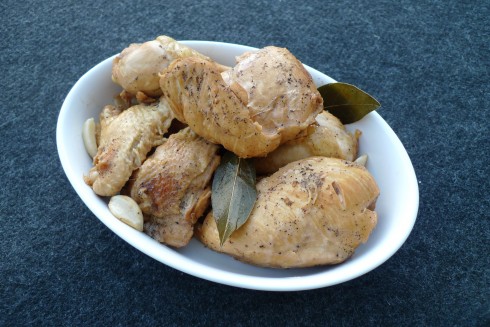
“Filipino food is delicious because it is cooked with love and always served with generosity and hospitality.”
One of the greatest pleasures of working at Omnivore Books is getting to learn about different cultural cuisines.
For the second Foodbuzz Next Food Blog Star assignment, we’ve been tasked to tackle a classic dish from another culture. My immediate thought: Chicken Adobo. Pungent, tasty, and shockingly easy to make, Adobo is a staple of Filipino cuisine.
Filipino food is finally getting its moment in the sun. In Los Angeles, good Filipino restaurants are ubiquitous and the younger generation are clamoring to embrace their cultural food roots. In New York, Amy Besa and Romy Dorotan created a sensation with their restaurant Cendrillon in Manhattan, and more recently moved out to Brooklyn to open the Purple Yam. Here in the Bay Area, Filipino restaurants are on the rise too, and food trucks Adobo Hobo, Hapa SF, and Senor Sisig are producing both contemporary and traditional versions of Filipino classics.
A few months ago, Filipino chef and cookbook author Amy Besa came for a talk at Omnivore Books. To be honest, having grown up in New Hampshire, I had never experienced true (or even bastardized) Filipino cuisine. While Besa spoke, I feverishly took notes.
In addition to being an incredibly warm and friendly woman, Besa is above all an intellectual. “If you are going to write a cookbook,” she elaborated, “I would recommend that you read a lot first. And use food to learn about history. If you try to trace back to where your food came from, you are doing history, and all of a sudden [history] is very exciting!”

(Photo: Allison Michael Orenstein, Time Out NY)
“Filipino food is fundamentally about balance, subtlety, nuance and harmony.”
People tend to itemize Filipino dishes rather than contextualize them. A good way to think about any cultural cuisine is to look at it from a historical perspective: food that is ours, and food that is borrowed. The Philippines experienced a long history of colonialism and occupation, and the food culture was greatly influenced over time. Besa noted that “Filipinos were very good at borrowing foods – the foods that they liked, they indigenized.”
Arab traders had been passing through for eons, and over several hundred years the Philippines were ruled by Spain, and then really ruled by Mexico. You can see this in influences such as Pampanga Bringhe – the Filipino version of Paella (made with sticky rice with coconut, turmeric, and native chicken.) There were very few influences from Mexico, but those include tamales made with rice, and other crossovers such as the use of lye.
Existing in Southeast Asia, they also had many influences from across the region. Immigrants from the Fujian mountains couldn’t use a lot of vegetable oils because they were cost prohibitive to the poor Fujian, so they used pork as fat, which was brought over to the Philippines. Then the Cantonese came with their cultural influences, and as richer communities they brought lighter foods such as stir fries.
In the 50’s, the United States came to occupy the country. Besa noted, regretfully, “Television came on in the 50’s and the big companies started cooking shows to promote their products (and in doing so destroyed generational culinary transfer).The new medium got totally divorced from the values of food you got from your grandmother.”
Besa made it her mission to preserve some of the old ways in her book “Memories of Philippine Kitchens“.
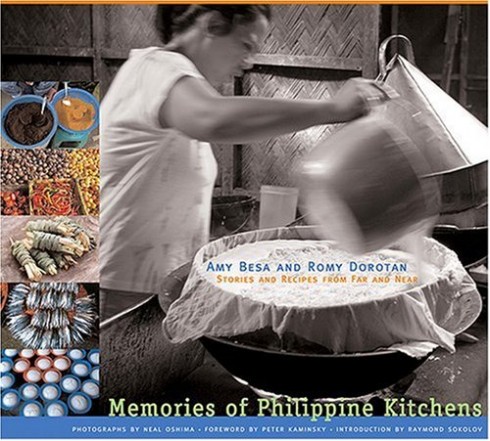
“No matter how rich or poor – Adobo is always on the table, and there are universal rules.”
In many Filipino dishes — including Adobo – a traditional marinade technique, Sinigang – a soup of meat or seafood with tropical fruits, and Kinilaw – a seafood preparation similar to ceviche — the common flavor is sourness. Besa explains this as defining the Filipino palate. The ingredients are the key to the culture, and “Every ingredient you put into your food has got to mean something”. In her restaurant, Besa imports coconut sap vinegar, heirloom rice, and salt from the Philippines. “Everytime I use heirloom rice, I eat up the price – it supports a farmer – that’s the taste of our soil. Of our culture. For me, that’s how I show my pride. It’s not always the best business model, but it is what makes us happy.”
When I set out to choose a recipe for Adobo, I thought about Amy’s rules for creating a recipe and the importance of dealing with ingredients and showing respect for the dish. A good recipe will explain how the dish came about into being, and what you are trying to do with it. You find a lot of truths in classic combinations. You use the very best ingredients.
There are endless combinations of Adobo recipes, but the key components are the sweet, sour, and slightly spicy flavors infused in the meat and vegetables. The technique has been native to the Philippines for centuries, and it was only after the Spaniards came that it was renamed. (Adobo is a Spanish word for the marinades in Spain and Mexico that slightly resembled the Filipino dish.)
For my version of a Filipino Adobo, I used chicken, soy sauce, rice vinegar, coconut milk, bay leaves, black peppers, and chiles. I made some modifications based on what was in my own kitchen (ie: low sodium soy sauce, and lite coconut milk), but the beauty of Adobo is that as long as you have that wonderful sour flavor from the vinegar, and the sweet coconut, it tends to turn out well every time.
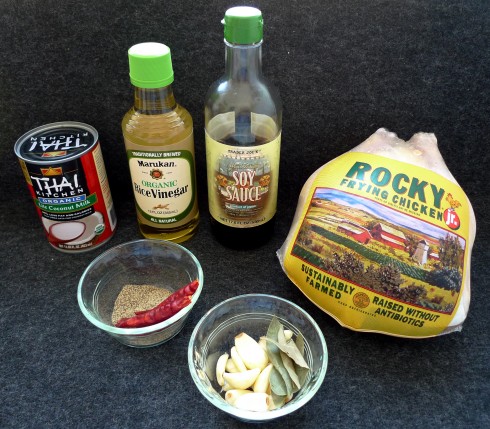
“Cookbooks are a roadmap to our identity, our history, and our roots.”
When Besa spoke about creating the cookbook, I immediately felt moved by her influences and how thoughtful she was about the process.
“I first had to make my cookbook really personal – my love of food comes from my grandmother. It’s a way of preserving memory. Ask a person who is dying about food memories. … Every family should record their treasured recipes…. In generations past, you knew where your food came from. Your Grandmother wouldn’t take shortcuts – it would be the best.
Her first rule of writing cookbooks is to find a muse. For her, it was Doreen Gamboa Fernandez – whose books led Amy to learn more about Filipino foods. She re-read them every year to make her understanding of Filipino food and culture deeper.
It took Amy and Romy four years to put together this book. They traveled back to the Philippines, where she hadn’t been since she had left Manila 30 years before, during a period of political unrest. She traversed the country taping oral histories. What’s your name? How do you do this? “[It is] amazing what you can discover. You become very attuned to the ingredients. The knowledge of the people [like being acutely aware of the stages of a coconut] – just amazing – once you accumulate all that information, you raise the level of information by seeing universalities of all things.”
At one point, an external editor tried to take it over. Besa was adamant: “You can not take out Mahjong. She wanted to cut out the personal. Her notes were kind of racist – too much about grannie, boring.”
For me, “Memories of Philippine Kitchens” has become one of my most treasured cookbooks on my shelf. The material was totally new to me, and I realized that there was so much to discover about my own food and cultural roots — it has inspired me to start writing my own food histories.
“If you really love and respect your culture and food, you would not come up with anything less than the best.”
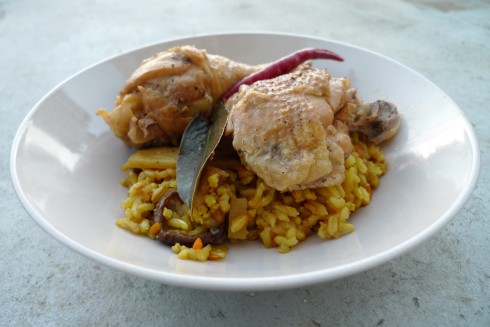
Chicken Adobo
Excerpted from Memories of Philippine Kitchens by Amy Besa and Romy Dorotan (Stewart, Tabori & Chang, 2006).
Serves 4 to 6
This is the recipe we use at the restaurant. The coconut milk helps keep the chicken moist and it makes a rich sauce. We serve this with Mushroom and Bamboo Shoot Rice (recipe follows) and sautéed mustard greens or bok choy. There are countless variations of chicken adobo; Mary “Inday” Gancayco serves a memorable mixture of chicken and pork adobo coated with mashed chicken livers and topped with fried garlic.
Marinade:
1 1/2 cups rice vinegar
1 cup coconut milk
1/4 cup soy sauce
12 garlic cloves, peeled
3 bay leaves
3 whole birdseye chiles
1 1/2 teaspoons freshly ground black pepper
One 3 1/2-pound whole chicken, quartered and cut into pieces
In a large nonreactive bowl or heavy-duty, resealable plastic bag, combine all of the marinade ingredients. Add the chicken pieces and turn to coat in the marinade. Refrigerate for at least 2 hours or overnight.
In a large casserole or Dutch oven, heat the chicken and marinade over high heat. Bring to a boil, then reduce the heat and simmer, stirring occasionally to make sure the chicken is covered in the marinade, until the chicken is cooked through and tender, 20 to 25 minutes.
Transfer the chicken pieces to a large bowl, raise the heat to medium-high, and reduce the sauce until it is the consistency of heavy cream, about 5 minutes. Remove the bay leaves and chiles. Return the chicken to the sauce and cook until just warmed through.
* * *
Inspired by Besa’s suggestions in her book, I served the Adobo with a rice made with Shiitake mushrooms, bamboo shoots, and turmeric. For two people, I sauteed a half an onion (chopped) with a grated carrot, for a few minutes until soft. I then added 3 cloves of garlic (minced), and cooked for another minute. I then added 1/4 pound of shiitake mushroms, and 1/2 cup of chopped bamboo shoots, and 1/4 teaspoon of turmeric. I stirred, and added 1 cup of Koda Farms Multi-grain blend (brown rice, quinoa, etc.) from Rainbow Grocery, and topped with an inch of water. I brought it to a boil and set it to simmer for 45 minutes until cooked.
* * *
F0r more good reading – a few food bloggers whose posts on Filipino food have inspired me:
Arnold @ http://www.inuyaki.com/
Marvin @
MarketMan @ http://www.marketmanila.com/
Connie @ http://homecookingrocks.com/
Erika @ http://ivoryhut.com

















